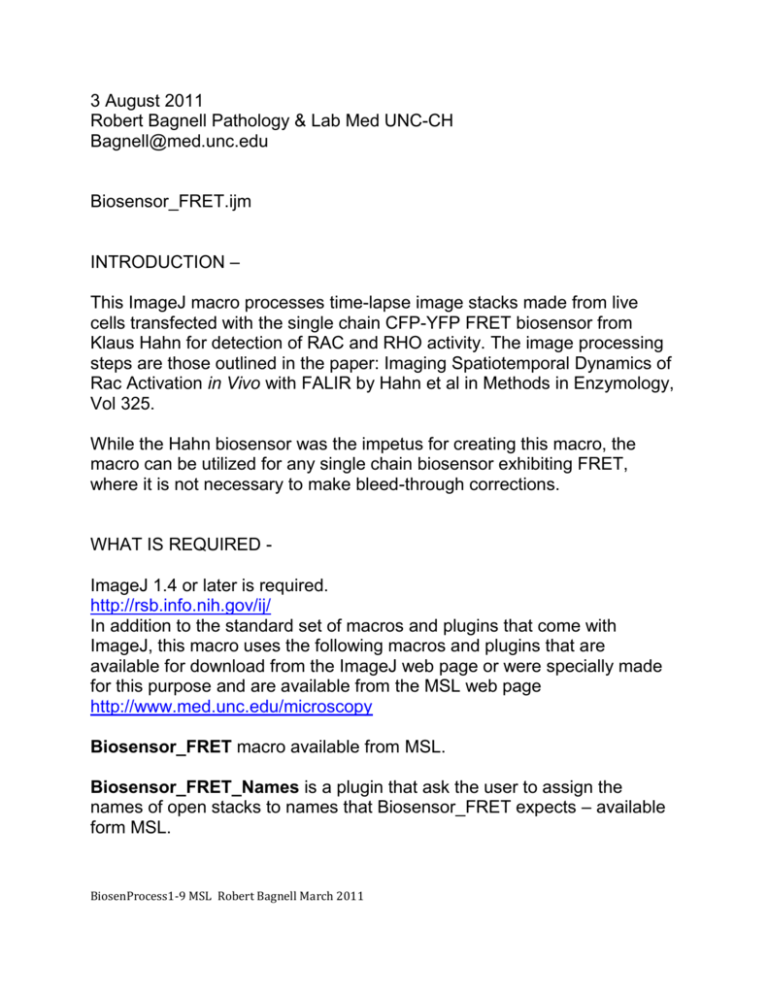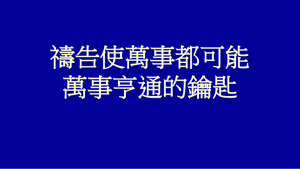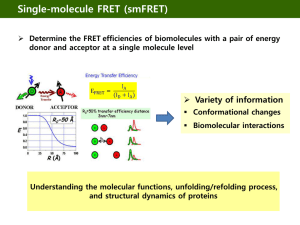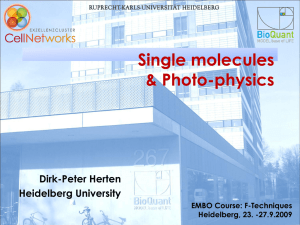Biosensor_FRET Macro Description
advertisement

3 August 2011 Robert Bagnell Pathology & Lab Med UNC-CH Bagnell@med.unc.edu Biosensor_FRET.ijm INTRODUCTION – This ImageJ macro processes time-lapse image stacks made from live cells transfected with the single chain CFP-YFP FRET biosensor from Klaus Hahn for detection of RAC and RHO activity. The image processing steps are those outlined in the paper: Imaging Spatiotemporal Dynamics of Rac Activation in Vivo with FALIR by Hahn et al in Methods in Enzymology, Vol 325. While the Hahn biosensor was the impetus for creating this macro, the macro can be utilized for any single chain biosensor exhibiting FRET, where it is not necessary to make bleed-through corrections. WHAT IS REQUIRED ImageJ 1.4 or later is required. http://rsb.info.nih.gov/ij/ In addition to the standard set of macros and plugins that come with ImageJ, this macro uses the following macros and plugins that are available for download from the ImageJ web page or were specially made for this purpose and are available from the MSL web page http://www.med.unc.edu/microscopy Biosensor_FRET macro available from MSL. Biosensor_FRET_Names is a plugin that ask the user to assign the names of open stacks to names that Biosensor_FRET expects – available form MSL. BiosenProcess1-9 MSL Robert Bagnell March 2011 StackAverage_16 is a16-bit version of the standard ImageJ plugin StackAverage - available from MSL. Infinity_to_zero is a plugin that sets any pixel in a 16-bit stack that is 65535 to 0 - available from MSL. Shading_Corrector plugin form the ImageJ plugins collection at http://rsb.info.nih.gov/ij/plugins/index.html SubtractMeasuredBackground from the ImageJ macros collection at http://rsbweb.nih.gov/ij/macros/SubractMeasuredBackground.txt TurboReg plugin from http://bigwww.epfl.ch/thevenaz/turboreg/ DoRT_Curve_Fit_Bob is a plugin that utilizes the built-in ImageJ curve fitting routines to do a double exponential curve fit in the Photobleach correction section - available from MSL. For imaging systems that save an alternating sequence of CFP / FRET images as a single file, such as Velocity, the plugin SubstackMakerPlus, from MSL, can be used to easily create separate CFP and FRET image stacks. This plugin is an adaptation of the ImageJ plugin SubstackMaker. These plugins should be installed in the ImageJ Plugins folder and the Subtract Measured Background macro in the ImageJ Macros folder. Placing the Biosensor_FRET macro in the Plugins folder will make it available in the ImageJ Plugins menu. Image stacks for the plugin are made as follows: 1. The CFP stack is a series of images over time in the CFP setting (CFP excitation, CFP emission). 2. The FRET stack is a companion time series of images in the FRET setting (CFP excitation, YFP emission). 3. The CFPdark and FRETdark series are taken in the CFPsetting and the FRETsetting with the light path to the camera blocked (about 20 images each is enough; exposure times should be manually set to about the same as for CFP and FRET). These are for correcting the camera’s dark current. BiosenProcess1-9 MSL Robert Bagnell March 2011 4. The CFPshade and FRETshade sets are taken in their respective settings from an area of the sample that has no cells, with the microscope slightly defocused, and with a small amount of very dilute fluorescein well mixed into the culture medium to produce an overall fluorescence (about 20 images each is enough). The brightness of these images should be only about 1/5 the brightness of the CFP and FRET images. These are for correcting the uneven illumination of the imaging system. Before the Biosensor_FRET macro is started, six stacks of images must be open. The macro will ask you to assign your open stacks to the following names, so your names can be different from these. CFP CFPshade CFPdark FRET FRETshade FRETdark HOW TO USE IT - 1. 2. 3. 4. 5. 6. 7. Brief protocol for using the macro: Drop the 6 image stacks on ImageJ. Select the Biosensor_FRET macro in the Plugins menu. Assign your stack names to the macro’s names. Use the check box to select/unselect dark correction. Use the check box to select/unselect sub-pixel registration. When asked in a dialog box to draw an area of interest (AOI) in a background region, use the rectangle tool to choose a background region. Look through the entire stack to be sure no bright artifact drifts into the region you choose. Click OK in the dialog box. Repeat for the second stack of images - the box you drew in the first stack is duplicated in the second stack so you only have to click OK. When asked to set a threshold, if the Adjust Threshold window is not open, open it (Image/Adjust/Threshold). Select the Dark Background BiosenProcess1-9 MSL Robert Bagnell March 2011 check box (ImageJ 1.4 required). Adjust the red threshold to cover the entire cell without extending the selection beyond the cell border. Click OK in the Action Required dialog box. Repeat for the second stack. 8. A photobleach curve is generated based on the threshold settings in step 7. These settings have a large effect on the photobleach calculation so you will be given a chance to change the settings in case the result is not satisfactory. When a “Simplex Fitting Options” dialog box appears click its’ OK. Examine the generated curve in the “Curve Fit” window and the R^2 value in the “Message” window (close to 0.95 is good for R^2). Click OK in the Message window. If you are happy with the curve fit, uncheck the retry checkbox and click OK. If you are not satisfied with the fit, choose to repeat the curve fit with a different threshold selection by clicking OK in the Retry box. When asked, set a threshold on the brightest part of the cell and click OK in the dialog box. Repeat for the second stack. You can repeat this process as many times as you like. 9. Select a lookup table (Image/Lookup Tables) and click the play button on the resulting image sequence. To see the values of the lookup table select Image/Color/Show LUT. The Log window shows the values of the curve fit for each image. The Results window shows the photobleach correction value by which each image was multiplied. WHAT IT DOES The macro is extensively documented within the micro file. In general, it performs the following steps in order: 1. Check to see if 6 stacks are open and exit if not. 2. Assign user file names to macro file names. 3. Ask if the user wants to do dark correction. 4. Ask if the user wants to do sub-pixel registration. In some cases subpixel registration is not necessary and it saves time to omit it. 5. Open a text window to show progress of the macro. The text window is in the upper left corner of the screen. 6. Create an averaged image from each of the dark noise stacks. 7. Stacks and images that are no longer needed are closed. BiosenProcess1-9 MSL Robert Bagnell March 2011 8. The averaged dark current images are subtracted from their respective stacks (CFP, FRET, CFPshade and FRETshade) then averaged shade images are made from each of the shade stacks. 9. Shade correction is done by dividing the CFP and FRET stacks by their averaged shade images using the Shading Corrector plug-in. 10. Background subtraction is done by asking the user to choose an appropriate background region in the CFP stack. The same region is also used in the FRET stack. The average intensity of that region is calculated and subtracted from every pixel of every image in the stack. NOTE: It is a good idea to look through the stack to make sure no bright artifact drifts into the background region that you choose. 11. Sub-pixel registration, if selected, is done using the TurboReg plugin selecting rigidbody (translation and rotation) registration in automatic and accurate mode. The image pair being registered are copied from their stacks, registered and the FRET image returned to its stack in place of the unregistered image. The FRET images are registered to the CFP images. Registration is done prior to masking because TurboReg does some image processing and uses every pixel in the image during registration so a previously masked image cannot be used. TurboReg produces a “Refined Landmarks” table that indicates the amount of adjustment that was made for each of the three landmarks used in rigid body alignment. Comparing the source to target values in that table indicates the amount of adjustment in x and y that was made. Unfortunately only the last value is left on the table. 12. Images are masked such that the background intensity is 0 and the cells are grayscale. This requires that the user set a threshold on the cells using the Image/Adjust/Threshold dialog box. The user must select “dark background” in the dialog box before setting the threshold. A message box prompts the user to do this. 13. Photobleach correction is started by using the threshold that was set in the masking step. The user can change the threshold if the result is not satisfactory. Photobleach correction is based on the ratio of the change in mean brightness of the thresholded parts of the cells over time. FRET and CFP mean values are normalized to the first value in each set and a ratio is calculated of the normalized values. Thus ((FRETmean#/FRETmean1) / (CFPmean#/CFPmean1)) is calculated for every time point. This data is the Y-axis of a graph and image number (i.e. time) is the X-axis. A double exponential curve is BiosenProcess1-9 MSL Robert Bagnell March 2011 fit to this data. A “Simplex Fitting Options” window is displayed with default values. The user can change these values, but they should be OK. A curve fit graph is generated as well as a table giving the R^2 value for the fit (0.95 or better is excellent). Since setting the threshold can be tricky, the user is allowed to repeat this step, setting the thresholds themselves, if they are not satisfied with the curve fit or the R^2 value. After the FRET / CFP raw ratio stack is calculated, each image is multiplied by the inverse of the curve value at its respective time point to correct for the amount of photobleach. 14. The final FRET / CFP ratio is calculated and the photobleach correction is applied. The result is in 32-bit floating point. Before converting this to 16-bit integer, a histogram stretch is done to insure that all values are kept within range. The user should apply a look-up table of their choice (Image/Lookup Tables and Image/Color/Show LUT) to the resulting stack to get the best idea of pixel intensities. BiosenProcess1-9 MSL Robert Bagnell March 2011







